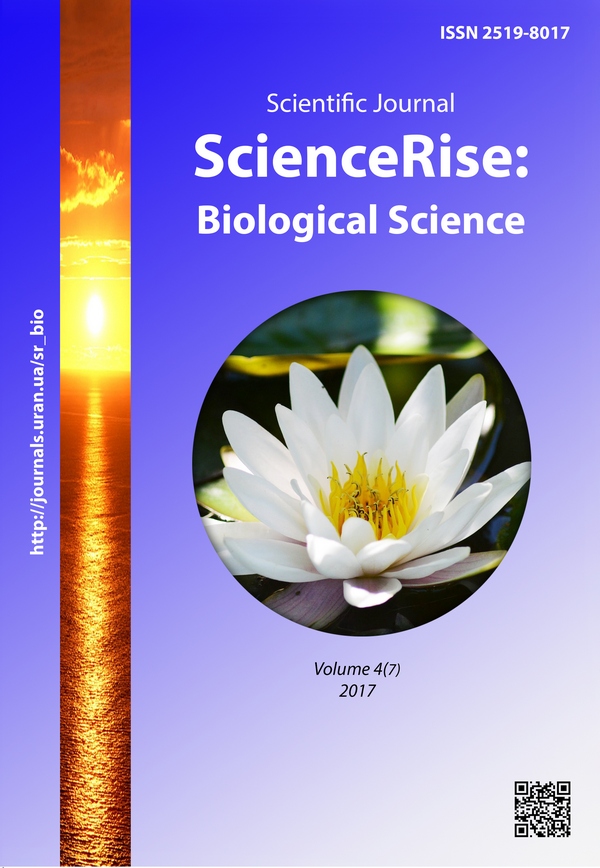Дослідження ліпідного складу жовчі щурів різної статі при дії тестостерону
DOI:
https://doi.org/10.15587/2519-8025.2017.108996Ключові слова:
тестостерон, фосфоліпіди жовчі, тригліцериди жовчі, етери холестеролу жовчі, міжстатеві відмінностіАнотація
Проводили гострі досліди на щурах. Використовували наркоз тіопентал натрію в дозі 60 мг/кг внутрішньоочеревно. Здійснювали канюлювання жовчної протоки. Вводили тестостерон пропіонат у дозі 0,7 мг/кг внутрішньом'язово протягом 5-ти днів. Він викликав збільшення концентрації фосфоліпідів, вільних жирних кислот, етерів холестеролу в жовчі. Вміст тригліцеридів зменшував у самиць, а у самців – збільшував
Посилання
- Shtroblia, A. L. (2015). Vyvchennya zhovchovydilno ta zhovchoutvoryuvalno funkciy pechinky v umovah tetrahlormetanovogo gepatytu pislya zastosuvannya ekstraktu z lystya abrykosu zvychaynogo [Research of bile excretion and bile formation functions of liver under conditions of tetrachloromethane hepatitis after use of the apricot leaves extract]. Achievements of clinical and experimental medicine, 1, 132–134.
- Schirmer, B. D., Winters, K. L., Edlich, R. F. (2005). Cholelithiasis and Cholecystitis. Journal of Long-Term Effects of Medical Implants, 15 (3), 329–338. doi: 10.1615/jlongtermeffmedimplants.v15.i3.90
- Wang, X., Magkos, F., Mittendorfer, B. (2011). Sex Differences in Lipid and Lipoprotein Metabolism: It's Not Just about Sex Hormones. The Journal of Clinical Endocrinology & Metabolism, 96 (4), 885–893. doi: 10.1210/jc.2010-2061
- Yagmur, V. B. (2013). Nealkogolna zhyrova hvoroba pechinky: suchasnyi poglyad na patogenez, diagnostyku ta likuvannya [Non-alcocholic fatty liver disease: modern view on pathogenesis, diagnosis and treatment]. Gastroenterology, 3 (49), 138–147.
- Vinnuk, Yu., Tsapenko, P., Lyaschenko, T., Veselskiy, S. (2014). Zhovchosekretorna funkciya pechinky shuriv za umov gidrokortyzovanogo navantazhennya [Billary secretion of brats liver in hidrocortizone load]. Bulletin of the T. Shevchenko National University Kyiv, 1 (66), 51–55.
- Cai, Z., Xi, H., Pan, Y., Jiang, X., Chen, L., Cai, Y. et. al. (2015). Effect of testosterone deficiency on cholesterol metabolism in pigs fed a high-fat and high-cholesterol diet. Lipids in Health and Disease, 14 (1). doi: 10.1186/s12944-015-0014-5
- Anoknina, G. A., Kharchenko, V. V. (2016). Vplyv preparative zhovchnyh kyslot na lipidnyi obmin u hvoryh z pislyaholecystektomichnym syndromom [Effects of the bile acid preparations on the lipid exchange in patients with the postcholecystectomy syndrome]. Modern gastroenterology, 2 (88), 29–34.
- Borovets, O., Bened, V., Reshetnik, E., Veselsky, S., Makarchuk, M. (2016). Zhovchnosekretorna funkciya pechinky samok shhuriv v umovah blokady estrogenovyh receptoriv tamoksyfenom [Bile Secretion Liver Function in the Female Rats at Estrogen Receptor Tamoxifen Blockade Conditions]. Scientific herald of the L. Ukrainka Eastern European National University, 7, 194–199.
- Korpachev, V. V., Melnychenko, S. V., Lukashova, R. H. (2015). Association of allele variants of receptor gene of androgens (by the number of CAG-repeats) with androgen. The Ukrainian Biochemical Journal, 87 (2), 26–40. doi: 10.15407/ubj87.02.026
- Veselsky, S. P., Liashenko, P. S., Kostenko, S. I., Gorenko, Z. A., Kurovska, L. F. (2001). Put. No. 33564 UA. Bioliquids method of sample preparation for determination of lipid substances of nature. MPK G01N 33/487. No. 99031324; declareted: 11.03.1999; published: 15.02.2001, Bul. No. 1, 3.
- Filimonova, N. B., Fil, I. O., Mikhailova, T. S. (2004). Statystychnyi analiz danyh vidpovidno do zasad naukovo obgruntovanoyi medycyny. Pervynnyi analiz kilkicnyh danyh, podannya rezultativ eksperymentu [Statistical analysis of data pursuant to the science-based medicine. Initial analysis of quantitative data, experimental results presentation]. Med. Railway Transport of Ukraine, 4, 86–93.
- Filimonova, N. B., Fil, I. O. (2005). Statystychnyj analiz danyh vidpovidno do zasad naukovo obgruntovanoyi medycyny. Porivnynnya grup za kilkisnymy pokaznykamy [Statistical analysis of data pursuant to the science-based medicine. Comparison groups in quantitative terms]. Med. Transport Ukraine, 4, 86–93.
- Kelly, D. M., Jones, T. H. (2013). Testosterone: a metabolic hormone in health and disease. Journal of Endocrinology, 217 (3), 25–45. doi: 10.1530/joe-12-0455
- Kelly, D. M., Akhtar, S., Sellers, D. J., Muraleedharan, V., Channer, K. S., Jones, T. H. (2016). Testosterone differentially regulates targets of lipid and glucose metabolism in liver, muscle and adipose tissues of the testicular feminised mouse. Endocrine, 54 (2), 504–515. doi: 10.1007/s12020-016-1019-1
- Wen, T. Y., Kang, D. M. (2017). Effects of testosterone replacement therapy on glucose and lipid metabolism in middle-aged and elderly high-fat-fed male rats. Biomedical Research, 28 (7), 3048–3052.
- Muraleedharan, V., Jones, T. H. (2010). Testosterone and the metabolic syndrome. Therapeutic Advances in Endocrinology and Metabolism, 1 (5), 207–223. doi: 10.1177/2042018810390258
- Boyer, J. L. (2013). Bile Formation and Secretion. Comprehensive Physiology, 3 (3), 1035–1078. doi: 10.1002/cphy.c120027
##submission.downloads##
Опубліковано
Як цитувати
Номер
Розділ
Ліцензія
Авторське право (c) 2017 Irina Chernuha, Evdokia Reshetnik, Stanislav Veselsky

Ця робота ліцензується відповідно до Creative Commons Attribution 4.0 International License.
Наше видання використовує положення про авторські права Creative Commons CC BY для журналів відкритого доступу.
Автори, які публікуються у цьому журналі, погоджуються з наступними умовами:
1. Автори залишають за собою право на авторство своєї роботи та передають журналу право першої публікації цієї роботи на умовах ліцензії Creative Commons CC BY, котра дозволяє іншим особам вільно розповсюджувати опубліковану роботу з обов'язковим посиланням на авторів оригінальної роботи та першу публікацію роботи у цьому журналі.
2. Автори мають право укладати самостійні додаткові угоди щодо неексклюзивного розповсюдження роботи у тому вигляді, в якому вона була опублікована цим журналом (наприклад, розміщувати роботу в електронному сховищі установи або публікувати у складі монографії), за умови збереження посилання на першу публікацію роботи у цьому журналі.










